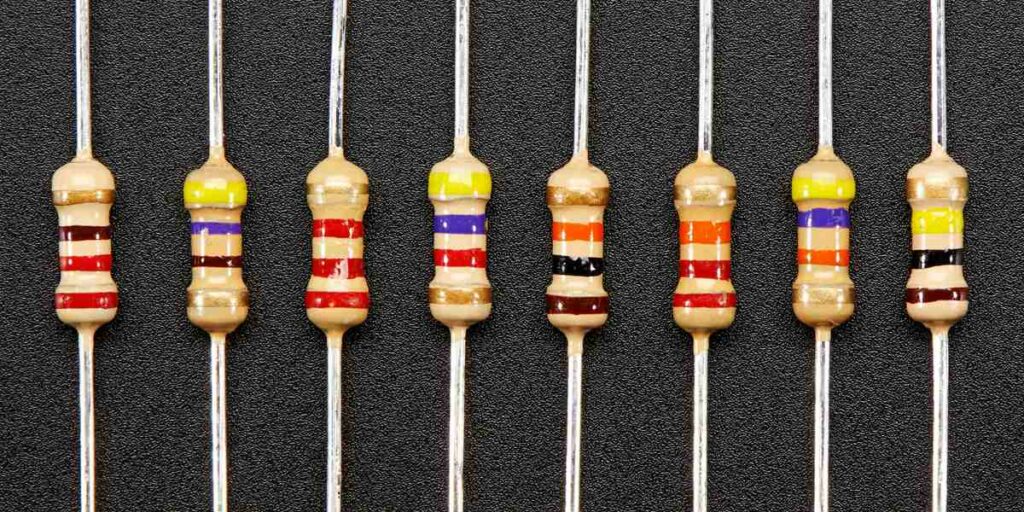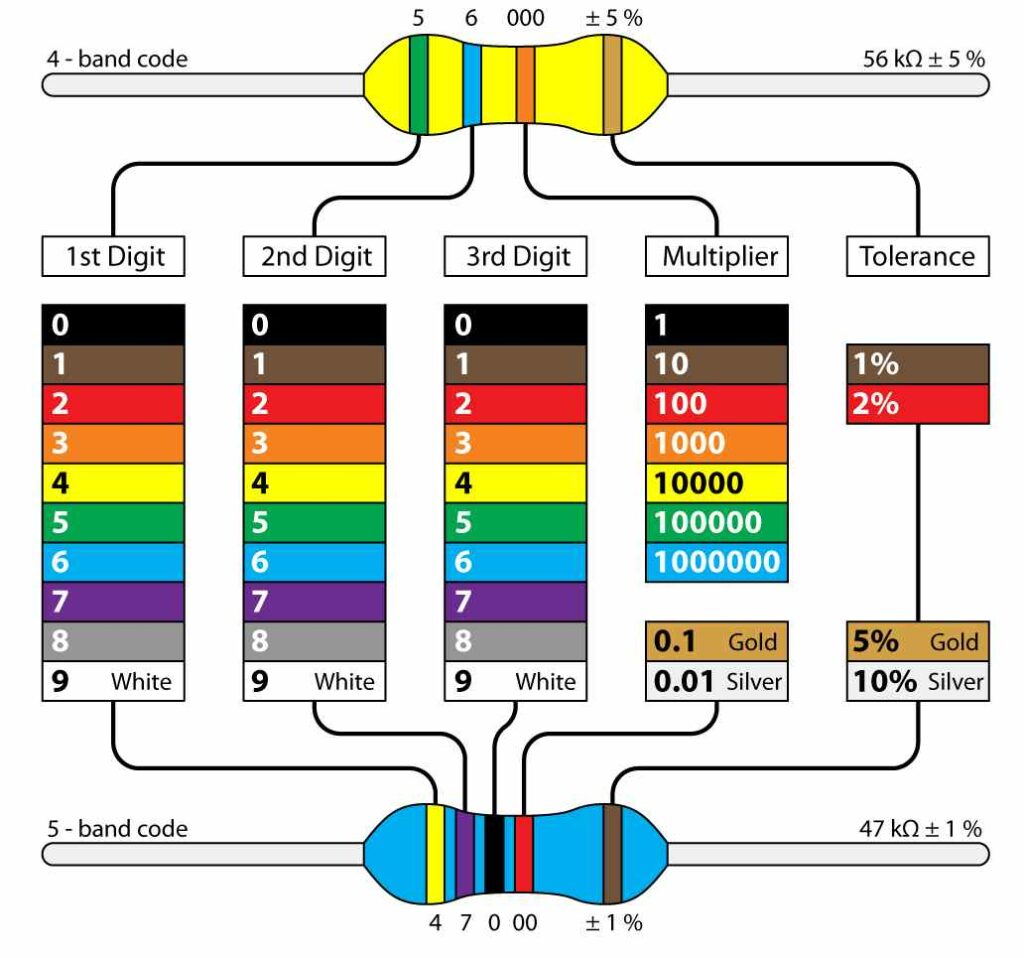Carbon composition resistors remain a highly popular type of resistor used across wide electronic applications from consumer products to industrial equipment even today despite introductions of alternative resistor technologies over decades.
In this guide, we specifically analyze key benefits offered by carbon resistors including:
- Material science background
- Property advantages
- Performance vs application tradeoffs
- Comparison with other resistor varieties highlighting niches where carbon resistors shine
- Manufacturing methods enabling cost optimizations
- New application areas emerging
Reviewing considerations around carbon composition resistors empowers engineers selecting the optimal resistor type matching complex modern application needs.
Background on Carbon Resistors
Carbon resistors consist of ceramic rod cores or pressed solid carbon cylinders containing powdered carbon particles bonded by various additive binder combinations to achieve desired resistance properties. Thin caps cropped from metal lead wires pressed together with carbon shape the traditional axial leaded resistor package terminated by end caps.
Carbon intrinsically exhibits higher yet imperfect and nonlinear electrical resistance modulated by compressing carbon particles more closely increasing interactions restricting electron mobility. This key concept underlying carbon resistors imparts unique characteristics versus other resistor types using metal alloy films, wire windings or solid semiconductor materials instead.
Key Electrical Property Advantages

Several inherent electrical phenomena emerging from the randomized compressed carbon particle matrix inside carbon resistors contribute useful behaviors:
Voltage Coefficient Effects
Applied voltage waveforms modulate apparent resistance nonlinearity widening/narrowing conducting pathways dynamically. This manifests changing resistor output facilitating mixing, detection and feedback circuits directly.
Extended Resistance Range Options
By adjusting carbon crushing grades and binder additives like ceramic, slurry resistance readily reaches from ohms to 100 megaohms economically using the same core resistive element materials meeting wide application needs.
Lower Inductive Noise
Carbon particles bonded in inherently chaotic configurations lack ordered metallic inductive loops reducing parasitic noise pickup versus wrapped wire wound equivalent resistors. This benefits signal integrity.
Enables Large Power Handling
Carbon’s intrinsically wide energy bandgap withstands significantly higher power dissipation density relative to size before experiencing thermal breakdown when properly derated. Values reach hundreds of watts.
These advantageous aspects of carbon resistors translate into appreciable performance benefits regarding certain specialized applications discussed next.
Performance vs Application Tradeoffs
While general purpose resistors emphasize precision tolerances at low cost, carbon resistors deliver value elsewhere:
Superior Impulse and Fast Rise-Time Performance
Carbon’s molecular scale conduction shunt paths distributed responsively withstand sharp ultrafast impulses without excessive distortion far exceeding metal filament inductances seen in wire-wound and metal film resistors. This suits switching service.
Higher Working Temperature Range
Properly selected binders allow carbon resistor operation exceeding 200°C significantly outperforming other common resistor materials enabling integration nearer heat sources or harnessing deliberate heat effects on resistance modulation.
Withstands Intermittent Overloads
Given carbon’s resilience against momentary energy surges, reasonably occasional power overloads professionally engineered into expected service conditions pose less concerns regarding immediate catastrophic failures. Slow wear-out degradation over time still results but offers suppression flexibility otherwise lacking from more fragile resistors.
Economical High Resistance Values
The facile adjustability binding carbon particles reaching beyond 1 gigaohm makes high value resistor requirements economical unlike semiconductor aproaches required realizing such elevated impedances ultimately price prohibitive even at modest quantities below 10,000 units.
The next section more closely examines typical carbon resistor construction elements tailoring performance.
Resistor Composition Materials Science
Carbon resistors supplement base carbon powders using various advanced filler ingredients determining electrical characteristics:
Ceramic Binders – Clay materials like aluminum oxide improve mechanical integrity and thermal conductivity reducing hot spots but increase cost.
Flame Retardants – Minerals containing boron, silicon, tin stabilizes carbon structure against oxidation/arcing damage at elevated temperatures improving safety margin.
Contact Enhancing Metal – Silver flakes layered between carbon particles lowers contact resistance between adjacent regions enabling far extended resistance range reach.
Insulating Films – Teflon, polyethylene and epoxy coatings containing wrapped carbon resistive cores prevents short circuiting while protecting oxidation facilitating soldered printed circuit board mounting.
Lead Wire – Typically copper or nickel-chrome connects to end caps while mechanically anchoring axially leaded resistors. Kovar matched expansion to ceramics interfaces connections minimizing stresses.
Together these supplemental ingredients bolster carbon composition resistors expanding capabilities matching diverse modern application requirements now surveyed.
New Application Areas Optimizing Carbon Resistors
Leveraging inherent carbon resistor advantages unique from other options creates opportunities targeting novel applications:
High Speed Switching – Supplanting wire-wound resistors eliminates parasitic inductance streaking fast edge digital logic signals across circuits improving speed.
RF Termination – Unique high frequency rectification effects from quantum electron tunneling aids lossless microwave reflection/termination applications unachievable otherwise.
Precision Calibration – Consistent compressed carbon binder modulus of elasticity facilitates force/pressure metrological calibration transferring strain measurements accurately.
Fusible Overload Protection – Judicious carbon resistor sizing safely blows open prematurely defending voltage/current surges substituting traditional fuses with properly derated wattage ratings.
Tunable Oscillators – Harnessing exponential thermal coefficient of resistance filtering feedback varies oscillating frequency agilely superior to fixed-value components enabling modulation/frequency hopping key securing noise resilient communications.
Thermistors – Certain binder formulations produce large precise resistance temperature sensitivity matching dedicated thermal sensor thermistor functionality economically.
These innovations highlight ongoing carbon resistor relevance persisting thriving among modern high reliability electronic systems. Next we’ll cover manufacturing processes enabling such continued carbon composition resistor viability going forward.
Carbon Resistor Manufacturing Methods
Dedicated factories evolved preparing high volume carbon resistors automated economically:
Slurry Mixing – Powdered carbon, ceramic binders, metals and flux ingredients compounded into optimized balanced formulations determine electrical characteristics. Homogenizing using distributive viscous mixing prevents composition gradients degrading performance.
Compaction Pressing – Granular premixed slurry powders compact under calibrated hydraulic uniaxial pressures between hardened polished tungsten carbide dies flattening resistor perform shape reliably hitting resistance targets through precision thickness control.
Binder Activation – Initially compressed crude resistor preforms run conveyors passing staged infrared heating zones between 300-600°C activating binders fully crosslinking carbon particles together solidifying final form net shape minimally needing finishing.
Termination Attaching – Silver alloy end caps expertly fused onto carbon slugs using acetylene torches or pulse arc welding achieves reliable low resistance contact critical for surface mount packaging.
Resistance Trimming – Incrementally ablating carbon film along resistor length rapidly using synchronized moving focused high power lasers delicately adjusts resistance downward to prescribed tolerances without cracking material.
Performance Testing – Electronics instrumentation electrically probes fabricated sample populations determining actual resistance distributions statistically filtering production batches for application suitability verifying tolerances confidently rated greater than 99.7% yields shipping.
These optimized techniques enable mass producing carbon composition resistors on scales exceeding billions yearly pushing costs down replacing antiquated manual piecework approaches improving consistency.
Comparison to Other Resistor Varieties

Contrasting carbon resistors versus other available options highlights advantageous niches:
| Resistor Type | Key Characteristics | Advantages | Disadvantages |
|---|---|---|---|
| Carbon | Randomized compressed carbon particles | Inexpensive <br> High resistance values <br> High power handling | Larger sizes <br> Looser tolerances ±5-10% typical <br> More noise |
| Metal Film | Evaporated metal alloy deposition on ceramic | Precise resistance tolerance ±1% <br> Lower noise <br> Smaller surface mount sizes | Lower max resistance 1MΩ <br>Lower max power 100mW-1W |
| Wire Wound | Metallic wire wraps around ceramic core | Very high power handling | Inductance effects inaccurate inability blocking high frequency signals <br> Larger sizes |
| Metal Oxide | Oxide layer on ceramic | Very high precision | Very low max power handling 10-50mW <br> Zero adjustability inflexible |
Therefore while lacking precision available from finely tuned processes benefitting other resistors, carbon composition delivers economically when moderate tolerance leeway acceptable or high resistance megaohm ranges mandatory pushing boundaries. Knowing selectively applying carbon resistors smartly optimizes overall system cost/functionality tradeoffs.
Frequently Asked Carbon Resistor Questions
Now we address common questions around properly working with carbon composition resistors:
Is oxidation or moisture absorption issues needing encapsulation protection?
Yes, exposed carbon resistor cores slowly oxidize raising resistances gradually over time around 5-10% after thousands operation hours unlike hermetically sealed protective coated variants or alternate more oxidation resistant resistor materials like ceramics or metal alloy films. Added moisture absorption effects compounds electrical parameter variation further degrading tolerances although exhibiting self-healing behavior when heat cycled drying reversibly. Hence for critical applications requiring stability past 1-3 years, consider moisture protection potting allowing easy encapsulated carbon resistor refurbishing/replacement periodically or substitute other resistor types from outset where necessary for extended field reliability above 5 years unattended operation if lacking maintenance access opportunities later mitigating oxidation drift rates suitably downrange.
What are typical carbon resistor power ratings actually suitable when temperature rise considered?
Established wattage ratings indicate power dissipatinggiving nominal ~60°C temperature increase above ambient maximum to avoid immediate failures, however practical design implementation should further derate electrical load power levels around half or below through deliberately sizing larger resistance values to hedge reliability allowing only ~20-40°C actual temperature rise keeping margins avoiding accelerated binder degradation from compounding thermal cycling strain damage causing excess variation threshold reductions much below peak specified wattage ratings long term.
Do carbon resistors emit RF noise needing shielding isolation?
Minimally – Carbon resistor intrinsic formations lack ordered crystallinity inherent metal alloy wires/films suppressing electron momentum harmonization sequence resonance buildup largely responsible coupling electromagnetic interference radiating typical wrapped inductive windings. Random matrix particle orientations significantly attenuate such noise emissions from carbon resistors specifically. Hence beyond standard good design practices following ground plane shielding/partitioning guidelines applied protecting general circuit areas noise susceptible, no special carbon resistor isolation precautions further needed as noise emissions remain below concerning margins affecting externally unless purposefully harnessed beneficially.
Why does power handling specification vary between carbon composition resistors models?
The maximum wattage power dissipation rating ultimately linked thermally conductance effectively shedding heat generated uniformly distributed across resistor area such that smaller geometry resistors despite equivalent resistivity material must derate power flowing correspondingly higher than physically larger resistors sizes given reduced surface cooling exposure effects concentrating substrate thermal density higher raising risks local breakdown spots overheating first. Hence power handling ratings directly correlate with component packaging overall size and materials where advantageous ceramic compounds or metal heat sink slugs tied contacting carbon cores boost ratings through improving lateral/vertical conduction spreading heat faster. Appropriately overspecifying helps ensure thermal limits never exceeded application operating conditions.
When should other resistor types substitute carbon composition instead?
Precision measurement instrumentation or evoked biological potentials (EEG, EKG, EMG) applications demand resistors with tight ±0.1- 0.5% tolerance predictability unavailable from baseline ±5% spec carbon requiring tighter process controls driving costs unsuitable competing against ±1% cheap thin film metal or ±0.1% metal oxide constructions where moderate temperature sensitivity variance also unacceptable influencing medical diagnostics sensor AFE signal chains or instrumentation reference feedback attenuation setting accuracy. Wire-wound inductive components inductance tolerances likewise problematic measuring MHz bandwidth RF signals despite economical power handling. Hence properly recognizing far broader general applicability carbon resistors niche window technical/pricing suitability helps guide appropriate engineering choices balancing system budget constraints.
This covers insider perspectives answering the most common questions around successfully applying carbon composition resistors across wide range modern electronic systems optimally. Please reach out to explore specific application needs tapping into additional specialty carbon resistors performance/geometry variants suiting growing cutting edge low volume requirements underserved by commodity catalogs when niche electrical characteristics proves mandatory pushing boundaries.
Conclusion
In conclusion, carbon composition resistors endure thriving today carving enduring niche roles thanks inherent nonlinearities, extended resistance ranges, high power handling, thermal reliability and economical formulation flexibility matching applications unachievable using alternate resistor technologies. Mastering nuances optimizing suitable applications maximizing unique carbon properties while mitigating shortcomings enables maximizing product functionality, safety and overall lifecycle value – cementing compositions ongoing importance next generation electronics ahead.
